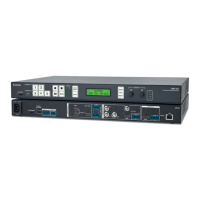SMP 300 Series • Front Panel Operations 45
Digital inputs are automatically set up using information regarding image size and refresh
provided by the digital input. This allows for non‑standard rates (not found in the input
lookup table) to display correctly. Digital inputs that do not match an existing lookup table
are saved to AutoMemory as unique entries based on the total line count, H/V active, and
vertical refresh rate.
Press NEXT to select the value and move to the next submenu.
Test Patterns
Test patterns are an essential tool for configuration and
troubleshooting.
The SMP300 Series offers eight patterns, applied per window:
color bars, time stamp, pulse (for audio), crop aspect ratio (1.33,
1.78, 1.85), and universal OSD patterns.
NEXT
NEXT
NEXT
NEXT
ADVANCED
CONFIG
Rotate { to toggle Auto
Memory On or Off.
Rotate either to select
reboot or to reset all
advanced configurations.
Rotate either to select a
test pattern.
Rotate [ to select input.
Rotate { to toggle on or off.
Rotate either to select
a resolution.
Rotate either to select
the drive restriction.
IN<1> AUTO IMAGE
<OFF>
TEST PATTERN
<N/A>
RESET
<NONE>
AUTO MEMORY
<ON>
PREVIEW HDMI OUT
<1280X720@60Hz>
RECORD DRIVE LIMITER
<OFF/ON>
PulseCrop
Aspect Ratio 1.33:1 Aspect Ratio 1.78:1 Aspect Ratio 1.85:1
Universal OSD
Time Stamp
)UL $SU
Figure 23. Test Patterns
• Color Bars — Standard full screen color bars overlaid on top of the current layout.
• Time Stamp (For composite mode only) – Displays white text in a small, translucent,
gray rectangle with the unit date and time (for example: Fri Apr 18 HH:MM:SS) in the
top left corner of the display window.
• Pulse — Select Pulse to output an audio pulse of 400 Hz at ‑10 dBu for audio output
testing.
• Crop — Outlines the active picture area.
• Aspect Ratio — Three patterns with screen outlines in 1.33:1, 1.78:1, and 1.85:1 for
centering and size adjustment.
• Universal OSD (For composite mode only) — This pattern consists of a small,
translucent, gray rectangle with white text overlaid atop the source video content.
It appears in the upper left of the screen. The text includes brief text of your choice
followed by three selectable elements separated by commas (see Setting up the
universal OSD test pattern on page78).
Rotate either ADJUST knob to scroll through the patterns. Stop on the desired pattern
and press NEXT. The selected test pattern is immediately output to the display. The test
pattern displays until another pattern is selected, OFF is selected from the TestPattern
drop‑down list, or unit power is recycled.
23

